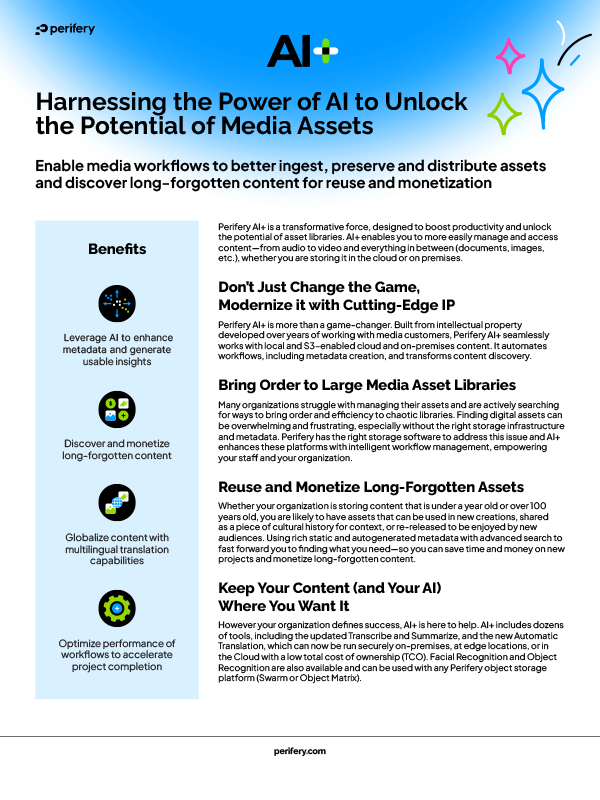
With the media sector at the forefront of technological innovation, ensuring the integrity of your valuable assets is crucial. In today’s data-driven world, maintaining workflow continuity and safeguarding assets is fundamental to meeting the changing demands of the industry – and those of the consumer. Many technologies have been designed to seamlessly evolve, there are certain systems still in use that can no longer adapt at the same pace as organizations’ needs. However, it’s not about lasting forever; it’s about the ability to stay relevant, efficient, adaptable, and most importantly, usable.
At the center of every media workflow is the asset storage system. Whether you're a filmmaker safeguarding cinematic masterpieces or a broadcaster managing a vast archive, you have a strong reliance on the capabilities of your storage architecture. It’s highly likely that, at some point, your media has been stored on some iteration of magnetic tape. And if so, you’re probably aware of the issues that come with every new generation release.
So, what are the options if your current storage solutions’ functionality is coming to an end?
- Option 1: Migrate to the next generation of tape (and repeat this process over and over), or;
- Option 2: Migrate to a future-proof, scalable object storage solution.
If you’re reading this blog, then it’s possible you are weighing up your options for your next move. Sure, you could stick with option 1 – we all love familiarity - but this approach requires repetitive migrations over the years as technology evolves. This cycle of migration becomes a perpetual loop which, over time, leads to increased complexities, higher maintenance costs, and drawbacks in both performance and efficiency.
Option 2, however, aligns seamlessly with the demands of modern data-driven workflows. Its scalable nature and inherent flexibility allow media companies to effortlessly adapt to the growing volume and complexity of content, without the worry of technology expiring.
Of course, both options come with the task of migration, but by going down the object storage route, this could mean it’s your last migration.
The seamless transition
Object storage is a transformative solution for the evolving demands of media workflows. Once you’ve found the right partner (if you haven’t, see our top tips), the next crucial step is to prepare your archive for migration. This phase is pivotal in ensuring a smooth transition, safeguarding data integrity, and optimizing the benefits of your chosen storage solution. And if you’ve chosen right, your object storage provider will make the move as easy and quick as possible.
1. Inventory
This initial process involves making a detailed catalog of your existing data assets, including the various types of media files, associated metadata, and the overall volume of content. This inventory serves as a crucial reference point, allowing you to gain deeper understanding of the scope of your data. By identifying the different types of assets and their relevance in your workflows, you can make informed decisions about what to prioritize during the migration process.
2. Organize Assets
Now you know what assets you have, it’s time to organize them. You should begin by decluttering to remove any obsolete or duplicate files - you’ll probably save a bit of storage space by doing this. You can then move to categorize your assets based on usage patterns and relevance. This organized structure will ensure a smoother transition while setting the stage for improved data management in the long term.
3. Timing
Determining the best timing for your migration is crucial. Potential downtimes need to be considered, and where possible, data migrations should be carried out during periods of lower activity to avoid disrupting operations. You also need to consider whether you will be moving your assets in one operation or taking a phased approach.
4. Data security
Safeguarding your content before, during, and after the migration is essential. Backup and recovery strategies should be implemented, as well as encryption protocols for additional layers of protection. By carrying these measures through, you’re not only facilitating a worry-free migration, but you’re also ensuring the confidentiality, integrity, and availability of your data assets for the future.
5. Accessibility
Maintaining accessibility to your data assets is paramount during the migration lifecycle, and beyond. Considering user-friendly interfaces, intuitive navigation, and robust search functionalities enhances accessibility and ensures that users can efficiently locate and interact with their media assets. By prioritizing accessibility features and user-centric design, you're not only streamlining daily operations but also maximizing the long-term benefits of object storage.
Once your data has transferred to the new object storage platform, you’ll be equipped with a foundation for streamlined data management. Your team will benefit from enhanced data retrieval capabilities, as well as seamless collaboration, faster content delivery, and improved workflow efficiency. The scalability of object storage allows you to effortlessly adapt to the growing volume and complexity of media assets. And the best part? You don’t have to worry about migrating your assets again anytime soon.
Perifery has helped many companies transition from legacy infrastructure to modern object storage. We facilitate the modernization of video workflows, simplifying the complex to ensure the safeguarding of assets and business continuity for the long-term. Get in touch to get started with your migration.
